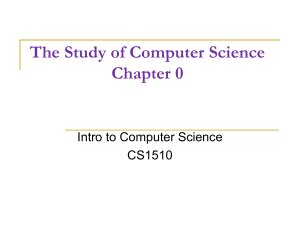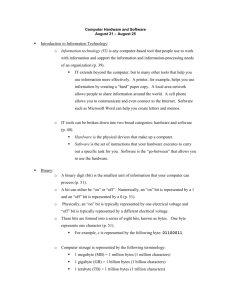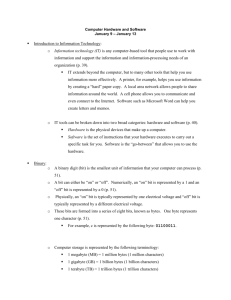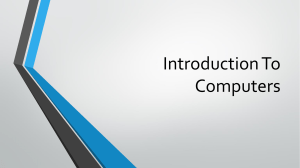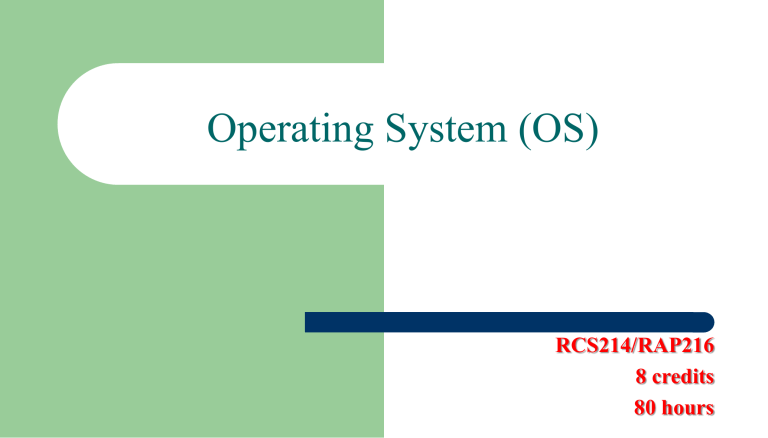
Operating System (OS) RCS214/RAP216 8 credits 80 hours What is computer? • A computer is a device that accepts information (in the form of digitalized data) and manipulates it for some result based on a program, software, or sequence of instructions on how the data is to be processed. • That is a device that consists of 1. Hardware and 2. Software. 2 Software • Software is a set of instructions, data or programs used to operate computers and execute specific tasks. It is the opposite of hardware, which describes the physical aspects of a computer • Software is used to control a computer. • There are different types of software that can run on a computer: 3 1. System software and 2. Application software. 3 1. System software. • Think of software as a layers, the system software is the bottom layer: • It sits between the hardware and the application software. • Here we have 1. Operating System 2. Utility Software and 3. Programming Software RCS207_1 4 4 1.1. Operating systems • Operating systems like Windows, macOS, Android and iOS are examples of system software (OS). • Operating systems are loaded into RAM when the device starts up, and have access to the hard drive. • Here we are: RCS214, RCS222 RCS207_1 5 5 1.2. Utility software • Utility software is part of the system software and performs specific tasks to keep the computer running. • Utility software is always running in the background. • Examples of utility software are security and optimization programs. • Security programs include anti-virus software that scans and removes viruses. • Most computers will include some sort of anti-virus software, but you can add your own. 6 6 1.3. Programming Software • Programming software, which provides the programming tools for software developers need . • Programming Software /Languages thus are responsible on developing the other software such as Application software, Os (example C programming) • All programming Languages Courses follow here. 7 7 2. Application software • This is everything else! Anything that is not an operating system , PL or a utility is an application or app. • So a word processor, spreadsheet, web browser, and graphics software are all examples of application software, and they can do many specific tasks. RCS207_1 8 8 Aim of the course • The aim of the course is to provide the basic theoretical principles/concepts of operating systems : 1. Services offered, 2. Memory management, 3. Process management, 4. I/O management, and 5. Security. • Provides the students with an overview of different types of operating systems, components of operating system, and a thorough knowledge of storage management. 9 Learning outcomes: • Upon completion of this course, the students should be able to: 1. Understand the key concepts of modern operating systems; 2. Specify the trade-offs of different algorithms in operating system design; 3. Apply the knowledge to system performance tuning and system administration; 4. Contrast the wide spectrum of operating systems in different 10 platforms Course Contents 1. Overview of computer system and operating system 2. Process Management, Process description and control, Process scheduling, Round-robin and priority scheduling. Deadlocks: Characterization – Methods for Handling Deadlocks – Deadlocks Prevention – Avoidance – Detection – Recovery. Threads, Symmetric Multiprocessing. 3. Memory Management, Partitioning, paging and segmentation, Virtual memory, Address translation and page fault handling, Memory management hardware: page table and Translation Lookaside Buffer, Memory management algorithms: fetch policy, replacement policy, resident set management and cleaning policy. 4. Input / Output Management and Disk Scheduling, I/O devices, Organization of I/O function, I/O buffering. 5. Disk scheduling, RAID. 6. File Management, Organization: files and directories. 11 7. Secondary storage management, file systems: FAT and NTFS Delivery and Assessment • Lab work. Students to work and practice various operating systems (DOS, WINDOWS, LINUX etc) • Methods of Instructions: Direct Instruction, Individual & Group Work, and Tutorials / Handouts • Assessment: 1. Involve quiz, test, assignment, and presentation which carries 40% 12 2. End of semester examination which Carries 60%. 3. Total 100% Readings 1. Silberrschatz at el (2004) Operating System Concept sixth Edition, John Wiley & Sons, INC 2. William Stallings (2005). Operating Systems: Internals and Design Principles, 5th edition. Prentice Hall 3. Deitel, H.M. (2003) Operating Systems, Second edition, Pearson Education 4. David A. Solomon, Mark Russinovich (2004). Microsoft Windows Internals, Fourth Edition: Microsoft Windows Server(TM) 2003, Windows XP, and Windows 2000 (ProDeveloper). Microsoft Press. 5. Remy Card, Eric Dumas, Frank Mevel (1998). The Linux Kernel book. John Wiley & 13 Sons. Operating System Overview Overview Content: 15 1. 2. 3. 4. 5. 6. 7. 8. 9. What is an OS. What are its key functions. Structure of Computer Systems Storage Overview Operating Systems mode Starting Operating System(booting) What are the popular types of OS. Basics of UNIX and Windows. Advantages of open source OS like Linux. Operating System What is an Operating System? • Computer System = Hardware + Software • Software = Application Software + System Software(OS) • An Operating System is a system Software that acts as an intermediary/interface between a user of a computer and the computer hardware. • Operating system goals: Execute user programs and make solving user problems easier Make the computer system convenient to use Use the computer hardware in an efficient manner 17 Operating System Definition 1. OS is a resource allocator – Manages all resources – Decides between conflicting requests for efficient and fair resource use 2. OS is a control program – Controls execution of programs to prevent errors and improper use of the computer 3. OS is an Interface – Interface between user and the computer 18 Structure of Computer Systems The Structure of Computer Systems 20 Accessing computer resources is divided into layers. Each layer is isolated and only interacts directly with the layer below or above it. If we install a new hardware device No need to change anything about the user/applications. However, you do need to make changes to the operating system. You need to install the device drivers that the operating system will use to control the new device. If we install a new software application No need to make any changes to your hardware. But we need to make sure the application is supported by the operating system user will need to learn how to use the new application. If we change the operating system Need to make sure that both applications and hardware will compatible with the new operating system. Computer Architecture 21 Special busses (roads) connecting all input/output devices to motherboard. CPU – Central Processing Unit • This is the brain of your computer. • It performs all of the calculations. • In order to do its job, the CPU needs commands to perform, and data to work with. • The instructions and data travel to and from the CPU on the system bus. • The operating system provides rules for how that information gets back and forth, and how it will be used by the CPU. 22 RAM – Random Access Memory This is like a desk, or a workspace, where your computer temporarily stores all of the information (data) and instructions (software or program code) that it is currently using. Each RAM chip contains millions of address spaces. Each address space is the same size, and has its own unique identifying number (address). The operating system provides the rules for using these memory spaces, and controls storage and retrieval of information from RAM. Device drivers for RAM chips are included with the operating system. Problem: If RAM needs an operating system to work, and an operating system needs RAM in order to work, how does your computer activate its RAM to load the operating system? 23 I/O Structure • After I/O starts, control returns to user program only upon I/O completion – Wait instruction idles the CPU until the next interrupt – Wait loop (contention for memory access) – At most one I/O request is outstanding at a time, no simultaneous I/O processing • After I/O starts, control returns to user program without waiting for I/O completion 24 – System call – request to the OS to allow user to wait for I/O completion – Device-status table contains entry for each I/O device indicating its type, address, and state – OS indexes into I/O device table to determine device status and to modify table entry to include interrupt Storage Overview Storage Definitions and Notation Review • • • • • • • • 26 The basic unit of computer storage is the bit. A bit can contain one of two values, 0 and 1. All other storage in a computer is based on collections of bits. Given enough bits, it is amazing how many things a computer can represent: numbers, letters, images, movies, sounds, documents, and programs, to name a few. A byte is 8 bits, and on most computers it is the smallest convenient chunk of storage. For example, most computers don’t have an instruction to move a bit but do have one to move a byte. A less common term is word, which is a given computer architecture’s native unit of data. A word is made up of one or more bytes. For example, a computer that has 64-bit registers and 64-bit memory addressing typically has 64-bit (8-byte) words. A computer executes many operations in its native word size rather than a byte at a time. Storage Definitions and Notation Review • Computer storage, along with most computer throughput, is generally measured and manipulated in bytes and collections of bytes. 1. 2. 3. 4. 5. 27 A kilobyte, or KB, is 1,024 bytes a megabyte, or MB, is 1,0242 bytes a gigabyte, or GB, is 1,0243 bytes a terabyte, or TB, is 1,0244 bytes a petabyte, or PB, is 1,0245 bytes • Computer manufacturers often round off these numbers and say that a megabyte is 1 million bytes and a gigabyte is 1 billion bytes. • Networking measurements are an exception to this general rule; they are given in bits (because networks move data a bit at a time). Storage Structure • Main memory – only large storage media that the CPU can access directly – Random access – Typically volatile • Secondary storage – extension of main memory that provides large nonvolatile storage capacity – Hard disks – rigid metal or glass platters covered with magnetic recording material • Disk surface is logically divided into tracks, which are subdivided into sectors • The disk controller determines the logical interaction between the device and the computer – Solid-state disks – faster than hard disks, nonvolatile 28 • Various technologies • Becoming more popular Storage Hierarchy • Storage systems organized in hierarchy – Speed – Cost – Volatility • Caching – copying information into faster storage system; main memory can be viewed as a cache for secondary storage • Device Driver for each device controller to manage I/O – Provides uniform interface between controller and kernel 29 Storage-Device Hierarchy 30 Caching • Important principle, performed at many levels in a computer (in hardware, operating system, software) • Information in use copied from slower to faster storage temporarily • Faster storage (cache) checked first to determine if information is there – If it is, information used directly from the cache (fast) – If not, data copied to cache and used there • Cache smaller than storage being cached 31 – Cache management important design problem – Cache size and replacement policy . Next: Operating System mode



